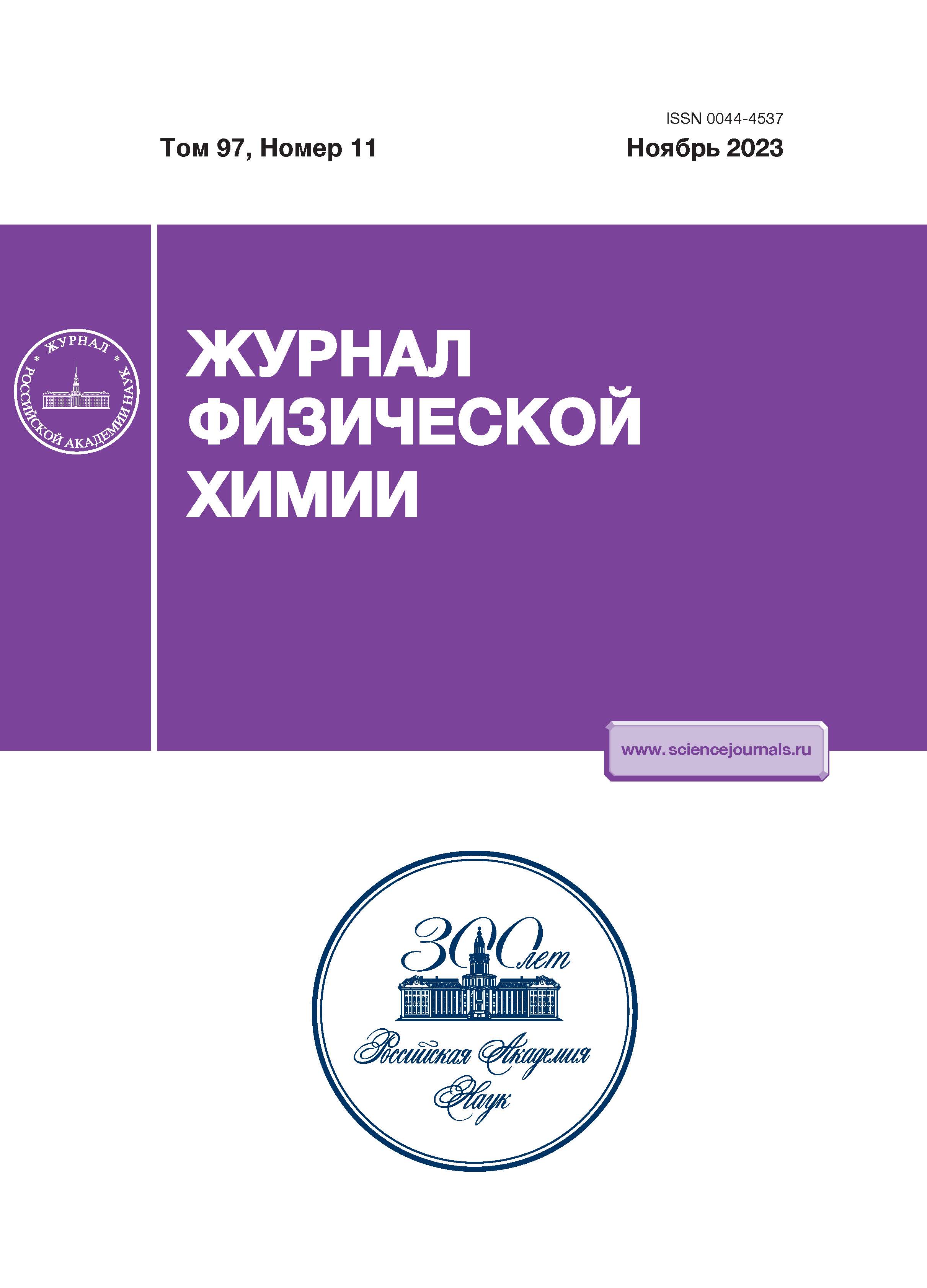Physicochemical and Catalytic Properties of the Mo–Zr/ZSM-5 Catalysts of Methane Dehydroaromatization
- 作者: Budaev Z.B.1,2, Korobitsyna L.L.1, Stepanov A.A.1, Gerasimov E.Y.3, Vosmerikov A.V.1,2
-
隶属关系:
- Institute of Petroleum Chemistry, Siberian Branch, Russian Academy of Sciences
- Tomsk State University
- Federal Research Center Boreskov Institute of Catalysis
- 期: 卷 97, 编号 11 (2023)
- 页面: 1584-1593
- 栏目: CHEMICAL KINETICS AND CATALYSIS
- ##submission.dateSubmitted##: 27.02.2025
- ##submission.datePublished##: 01.11.2023
- URL: https://rjonco.com/0044-4537/article/view/669167
- DOI: https://doi.org/10.31857/S0044453723110055
- EDN: https://elibrary.ru/KSNHRP
- ID: 669167
如何引用文章
详细
The effect of the method for the introduction of zirconium in the 4Mo/ZSM-5 catalyst and of its amount on the physicochemical and catalytic properties of the catalyst during the nonoxidative conversion of methane into aromatic hydrocarbons (benzene and naphthalene) has been studied. The catalyst was modified with zirconium by impregnation and solid phase mixing. The resulting zeolite catalysts were studied by IR spectroscopy, X-ray diffraction analysis, low-temperature nitrogen adsorption, temperature-programmed ammonia desorption, scanning and transmission electron microscopy, and simultaneous thermal analysis. With an increase in the zirconium concentration introduced in the 4Mo/ZSM-5 catalyst, the strength and concentration of its strong acid sites that are responsible for methane aromatization decrease regardless of the method of modification. The particle size and morphology of the catalyst, the distribution of Mo and Zr in them, and the presence of coke deposits on their surface were determined by scanning and transmission electron microscopy. The catalytic tests and subsequent thermal analysis of the samples showed that the addition of zirconium to the 4Mo/ZSM-5 catalyst leads not only to an increase in its catalytic activity, but also to operational stability due to the lower rate of coke formation. It was established that 4Mo/ZSM-5 modified with 1 wt % Zr by solid-phase synthesis is the most effective catalyst in methane dehydroaromatization (DHA).
作者简介
Zh. Budaev
Institute of Petroleum Chemistry, Siberian Branch, Russian Academy of Sciences; Tomsk State University
Email: pika@ipc.tsc.ru
634021, Tomsk, Russia; 634050, Tomsk, Russia
L. Korobitsyna
Institute of Petroleum Chemistry, Siberian Branch, Russian Academy of Sciences
Email: pika@ipc.tsc.ru
634021, Tomsk, Russia
A. Stepanov
Institute of Petroleum Chemistry, Siberian Branch, Russian Academy of Sciences
Email: pika@ipc.tsc.ru
634021, Tomsk, Russia
E. Gerasimov
Federal Research Center Boreskov Institute of Catalysis
Email: madiva@catalysis.ru
Russia, 630090, Novosibirsk, Pr. Ak. Lavrentieva, 5
A. Vosmerikov
Institute of Petroleum Chemistry, Siberian Branch, Russian Academy of Sciences; Tomsk State University
编辑信件的主要联系方式.
Email: pika@ipc.tsc.ru
634021, Tomsk, Russia; 634050, Tomsk, Russia
参考
- Ma S., Guo X., Zhao L. et al. // J. Energy Chem. 2013. V. 22. P. 1. https://doi.org/10.1016/S2095-4956(13)60001-7
- Wang B., Albarracin-Suazo S., Pagan-Torres Y. et al. // Catal. Today. 2017. V. 285. P. 147. https://doi.org/10.1016/j.cattod.2017.01.023
- Ramasubramanian V., Ramsurn H., Price G.L. // J. Energy Chem. 2019. V. 34. P. 20. https://doi.org/10.1016/j.jechem.2018.09.018
- Corredor E.C., Chitta P., Deo M.D. // Fuel Process. Technol. 2019. V. 183. P. 55. https://doi.org/10.1016/j.fuproc.2018.05.038
- Rahman M., Infantes-Molina A., Boubnov A. et al. // J. Catal. 2019. V. 375. P. 314. https://doi.org/10.1016/j.jcat.2019.06.002
- Chen L., Lin L., Xu Z. et al. // J. Catal. 1995. V. 157. P. 190. https://doi.org/10.1006/jcat.1995.1279
- Kiani D., Sourav S., Tang Y. et al. // Chem. Soc. Rev. 2021. V. 50. P. 1251. https://doi.org/10.1039/D0CS01016B
- Menon U., Rahman M., Khatib S.J. // Appl. Catal. A, General. 2020. V. 608. P. 117870. https://doi.org/10.1016/j.apcata.2020.117870
- Ogawa Y., Xu Y., Zhang Z. et al. // Resources Chem. Mater. 2022. V. 1. P. 80. https://doi.org/10.1016/j.recm.2022.01.004
- Kosinov N., Hensen E.J.M. // Adv. Mater. 2020. V. 32. P. 2002565. https://doi.org/10.1002/adma.202002565
- Chen L., Lin L., Xu Z. et al. // Catal. Lett. 1996. V. 39. P. 169. https://doi.org/10.1007/BF00805578
- Wang L., Xu Y., Wong S. et al. // Appl. Catal. A: 1997. V. 152. P. 173. https://doi.org/10.1016/S0926-860X(96)00366-3
- Liu S., Dong Q., Ohnishi R. et al. // Chem. Commun. 1997. № 15. P. 1445. https://doi.org/10.1039/A702731A
- Wang Q., Lin W. // J. Nat. Gas Chem. 2004. V. 13. P. 91. https://doi.org/10.1109/TIP.2004.823822
- Sridhar A., Rahman M., Infantes-Molina A. et al. // Appl. Catal. A, General. 2020. V. 589. P. 117247. https://doi.org/10.1016/j.apcata.2019.117247
- Восмерикова Л.Н., Волынкина А.Н., Восмериков А.В. и др. // НефтеГазоХимия. 2015. № 1. С. 37. [Vosmerikova L.N., Volynkina A.N., Vosmerikov A.V. et al. // Oil & Gas Chemistry. 2015. No. 1. P. 37 (In Russ)]
- Korobitsyna L.L., Zharnov K.N., Stepanov A.A. et al. // Journal of Siberian Federal University. Chemistry. 2019. V. 12. P. 118. https://doi.org/10.17516/1998-2836-0111
- Гусев А.И. Нанокристаллические материалы: методы получения и свойства. Екатеринбург: УрО РАН, 1988. 200 c. [Gusev A.I. Nano-crystalline materials: methods of obtaining and properties. Yekaterinburg: IPM UrO RAN, 1998. 200 p. (In Russ.)]
- Shukla D., Pandya V. // J. Chem. Tech. Biotechnol. 1983. V. 44. P. 147.
- Vosmerikov A.V., Echevskii G.V., Korobitsyna L.L. et al. // Kinetics and Catalysis. 2005. V. 46. № 5. P. 724. https://doi.org/10.1007/s10975-005-0128-2
- Zaikovskii V.I., Vosmerikov A.V., Anufrienko V.F. et al. // Doklady Physical Chemistry. 2005. V. 404. P. 201. https://doi.org/10.1007/s10634-005-0060-1
- Denardin F.G., Perez-Lopez O.W. // Micropor. Mesopor. Mater. 2020. V. 295. P. 109961. https://doi.org/10.1016/j.micromeso.2019.109961
- Stepanov A.A., Korobitsyna L.L., Vosmerikov A.V. // Catalysis in Industry. 2022. V. 14. P. 11. https://doi.org/10.1134/S2070050422010093
- Song Y., Zhang Q., Xu Y. et al. // Appl. Catal. A: General. 2017. V. 530. P. 12. https://doi.org/10.1016/j.apcata.2016.11.016
补充文件















